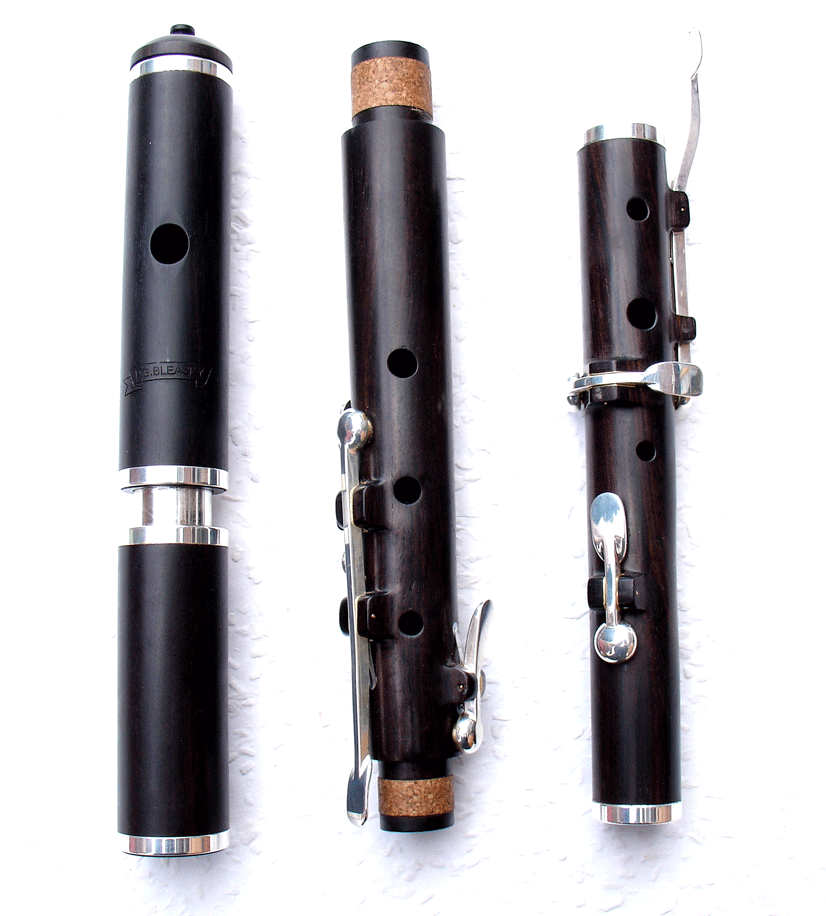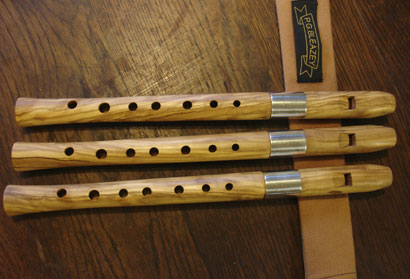TIMBER

| 
| 
|
 |
 |
 |
 |
 |
 |
 |

I am frequently asked to provide a description of the various timbers which I use in the production of my flutes as regards the appearance, weight, maintenance requirements and, most importantly, tonal qualities. I have compiled some observations here which will hopefully satisfy the enquirers curiosity. Included are notes on sourcing, preparation and seasoning.
It will help to have an understanding of some of the terminology
beforehand.
SPECIFIC GRAVITY
is given as a number indicating how many times a given material is heavier or lighter than an equal volume of water, the higher the number the denser and and probably, harder the wood. Figures are approximate as moisture content and rate of growth of any given tree can vary widely. For example a slow grown tree surrounded by others competing for nutrients will be more dense and harder.
TONE
is in this instance the sound we hear when an instrument is played, this sound is made up of "partials" of different frequencies which together we hear as one sound. Partials can be added or removed from a sound to alter its quality although the pitch of the note remains unchanged to our ears. An example of this is the treble knob on the Hi Fi system which adds in or takes out the higher frequency partials, we hear a change in quality but not in pitch.
AVAILABILITY
Unfortunately wood suitable for instrument making is not to be found in every timber yard by the tonne. One snatches up small quantities as and when they come available, sometimes from the most unlikely sources. I have a reputation in the area of France where I live in the summer months as a worthy artisan and local farmers often offer fruit trees when they have to be grubbed out. Regular calls round the dealers turn up small amounts from time to time and the grapevine brings in the occasional good lead. I avoid placing orders with large cutters of exotic woods as these are all too scarce and will disappear soon enough without my encouragement.
SEASONING
Fresh cut timber has to be dried for many years before it is ready to be used. I reduce this time by cutting to size and rough turning and boring before drying, thereby eliminating the need to dry the sawdust which will be discarded later anyway. For this reason I cannot always offer the customers first choice for some time, if at all. The only virtue is patience!
STAINING
Some of the less attractive woods benefit from staining and some of the early ones require it for authenticity. I sometimes fume with nitric acid, authentic but dangerous. More often I use finely filtered pigments to mix the required colour but I do not offer a custom colour service.
AFRICAN BLACKWOOD
is the most popular flutemakers wood although it is becoming rarer and I try to use less of it, encouraging the choice of mopani instead. The quality of this wood gets less as stocks are used up, recently cut material having more grey/brown stripes. For this reason I seek out blackwood which has been in store for many years, which is better for the preservation of the species too. A heavy wood S.G. 1.2 Favouring the low partials and giving good volume as well as a solid tone. Oiling is almost unnecessary although I recommend it in the playing in period.

6 KEYED FLUTE IN
AFRICAN BLACKWOOD
APPLE
is a light brown wood with little figuring, light in weight S.G. 0.45-0.5 requires frequent oiling to maintain tone and pitch, Apple produces nice recorders and not too loud, or aggressive whistles.
BOXWOOD (EUROPEAN)
A pale yellow with light figuring or sometimes grey/blue veining when the timber has been poorly stored, occasionally with astounding ripples which appear to move in changing light. Woodwinds in box are sometimes acid stained. Box is the densest of all European hardwoods S.G.0.85-0.9 and makes a wonderful mellow sound without too many high partials nor the solid low tone associated with African blackwood. Requires oiling infrequently to protect from moisture rather than to improve tone.
MAPLE
is a creamy white in colour with light figuring which can sometimes give a ripple effect as seen in violin backs, often stained, requires frequent oiling at first. A light wood, S.G. 0.5-0.6. Maple gives a soft sound suitable for early recorders.
MOPANI
A non endangered African hardwood similar in appearance to the rosewoods, (that is to say a reddish brown with varying degrees of dark brown figuring) many of which are becoming quite rare and for this reason I do not use them. Some people, myself included are allergic to the rosewoods and Mopani offers a non aggressive alternative. A very dense wood S.G.1.1 mopani favours the high partials and is the choice for musicians who want to be heard in loud sessions or outdoors. Requires little oiling and maintains a brilliant shine.
PLUM
Pinkish brown when first cut changing quickly to a darker brown on exposure to sunlight, often with attractive stripes and "flaming" SG. 0.6 giving a soft sound with good volume popular for whistles and early recorders.
PEAR
Just on the pink side of grey, little figuring, requires a lot of oil to achieve good results in the early stages. Many mass produced recorders are made from pear which has been impregnated with paraffin wax - yuk. SG 0.5 produces a soft tone suitable for recorders.
HOLLY
The second densest wood from Europe white through grey sometimes with light figuring plays like boxwood giving good volume and a mid range mellow tone. Requires little oiling. SG. 0.8
SOUTH AMERICAN OR CASTELLO BOXWOOD
Often called lemonwood, pale yellow in colour with little or no figuring requires regular oiling gives good tone and volume similar to the fruitwoods SG 0.7
OLIVE
A yellow wood with stunning dark brown figuring requires regular oiling to produce one of the best mid range tones for any woodwind instrument with lots of volume SG 0.8

OLIVE WOOD
YEW
Surprisingly, for a softwood, this attractive light weight timber gives a good soft tone which I have heard described as "creamy" sufficient volume but would get lost in a session. Colour is a light brown with good figuring in some pieces Sg 0.5, requires frequent oiling. Instruments in Yew are best described as parlour pipes and they are lovely.


Tel:- 0044 (0)1524 849085
Last Updated November 2022